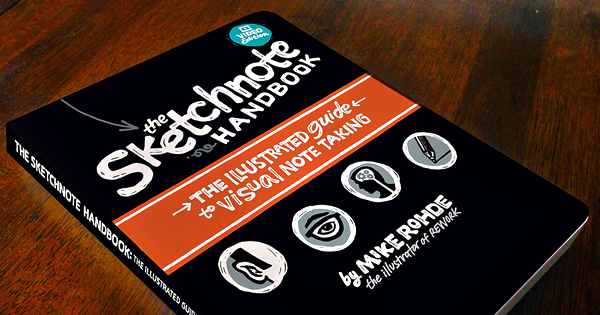The Sketchbook Handbook: The Illustrated Guide to Visual Note Taking by Mike Rohde was launched last week. This terrific new book is an essential guide to this relatively new branch of visual thinking.
Several years ago, Rohde coined the term “sketchnoting” to describe his unique hybrid of hand-written notes and drawings, and it has since grown rapidly in popularity, primarily via his richly-illustrated notes from the SXSW conferences and presentations there, plus two-best selling business books for which he created the illustrations. In the process, Rohde has become known as the “godfather of sketchnoting.” When I learned that he was writing The Sketchnote Handbook, I was very excited – for here was an opportunity to learn the thinking behind this rich form of visual thinking, from the master himself. Paging through it, I’m pleased to say that it exceeds my expectations. This is an amazing book!
What is sketchnoting?
To borrow Rohde’s definition from the book, “Sketchnotes are rich visual notes created from a mix of handwriting, drawings, hand-drawn typography, shapes and visual elements like arrows, boxes and lines.” He describes it as a whole-brained approach to taking notes that is more engaging to the brain of the person creating them, as well as providing a richer visual context to others who may view them. In this context then, sketchnoting is all about capturing ideas in a memorable way, not about creating artwork. Rohde emphasizes that you don’t need to be an artist to create sketchnotes; anyone can make them out of five basic shapes: the circle, square, triangle, line and dot.
The format of The Sketchnote Handbook
 In The Sketchnote Handbook, the medium IS the message: Its content is not communicated via endless paragraphs of boring text, but by a series of colorful black and orange sketchnotes. Just paging through this fascinating book drives home the point that images can communicate far more in a very compact space than multiple paragraphs of text. The book is divided into 7 sections:
In The Sketchnote Handbook, the medium IS the message: Its content is not communicated via endless paragraphs of boring text, but by a series of colorful black and orange sketchnotes. Just paging through this fascinating book drives home the point that images can communicate far more in a very compact space than multiple paragraphs of text. The book is divided into 7 sections:
- What are sketchnotes?
- Why sketchnote?
- Developing listening skills
- The sketchnoting process
- Types of sketchnotes
- Sketchnoting approaches, hierarchy and personalization
- Sketchnoting skills and techniques
Examples of sketchnoting
Rohde doesn’t pretend to be the “guru” of sketchnoting. He is from my hometown, and I’ve known him for at least 10 years. Mike is quite modest about his success with this form of visual thinking, and views himself as a member of a community who have been driving its evolution and learning from one another. Accordingly, The Sketchnote Handbook contains 1-2 page spreads, sprinkled throughout the book, that were provided by his contemporaries around the world. Their voices and perspectives add much richness to this unique book.
The video edition: A worthwhile investment
A special video edition includes a code that you can enter on publisher Peachpit Press’ website to access 20 videos, where Rohde demonstrates the drawing and sketchnoting techniques described in the book. For $US7.00 more, the video version of The Sketchnote Handbook is a worthwhile investment. It’s one thing to read about sketchnoting – it’s another experience all together to see it in action. Here is a video that provides an overview of what’s included in this series of tutorials:
[vimeo 48892571 nolink]
Conclusion
If you are fascinating by all types of visual thinking as I am, you will find The Sketchbook Handbook to be a valuable primer on this powerful yet easy to do learn of visual note taking. I highly recommend it!
Watch this blog for a podcast interview with Mike Rohde in the next week or so, where you will learn about Rohde’s views on the world of visual thinking, where sketchnoting fits in, similarities and differences versus mind mapping, and much more!
Related post: Sketchnoting: A closer look with its developer, Mike Rohde (podcast)


Leave a Reply